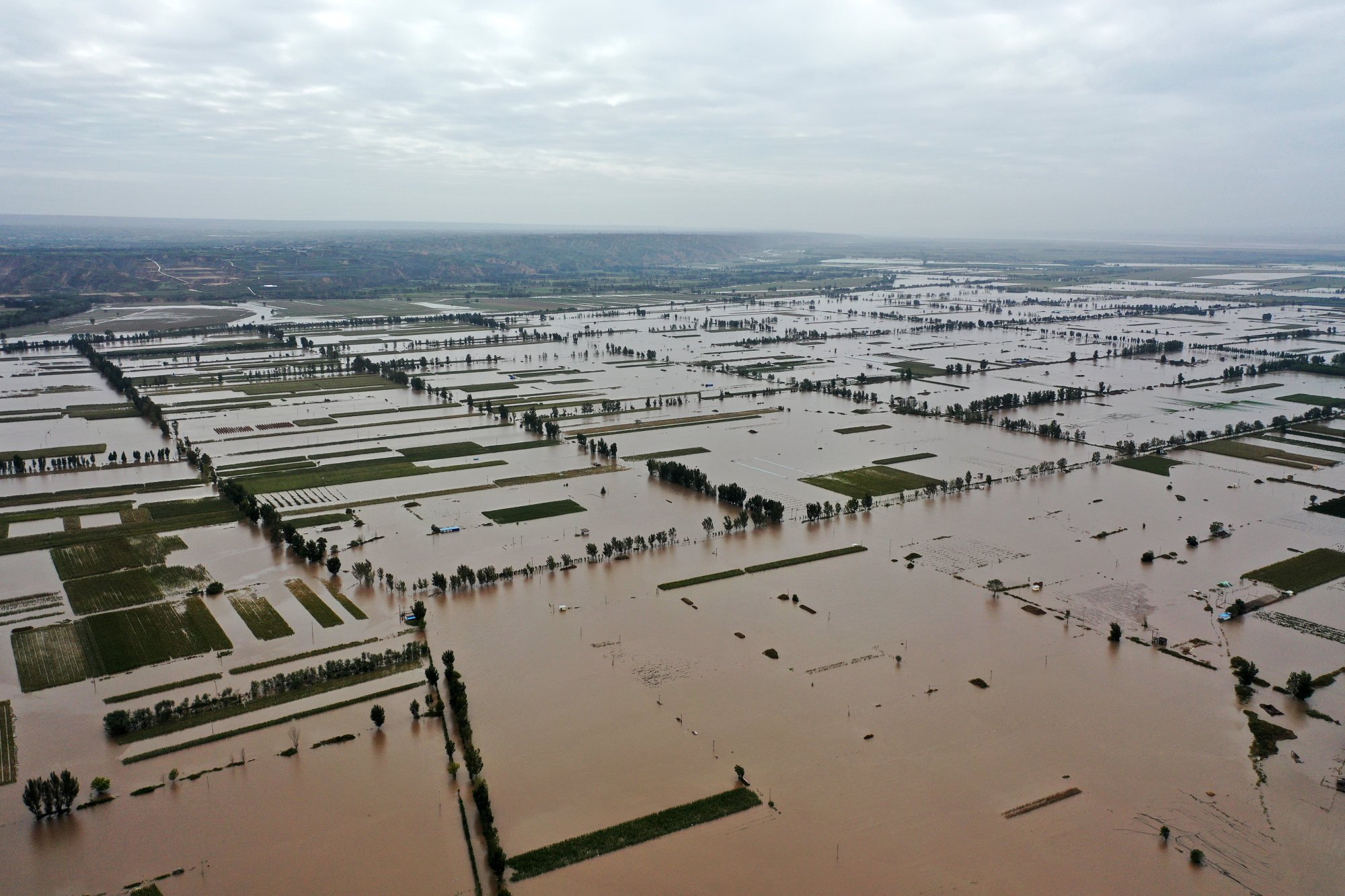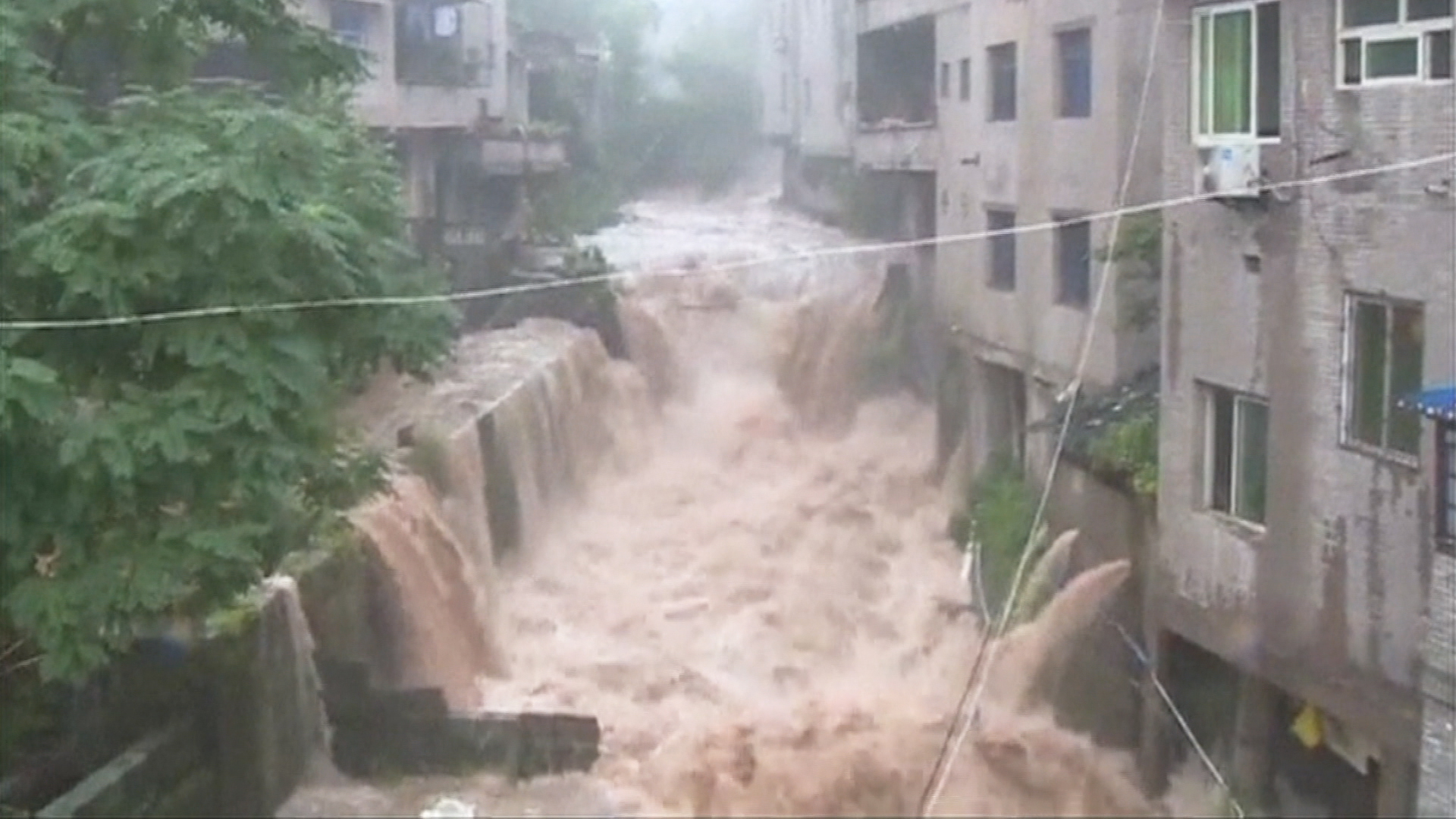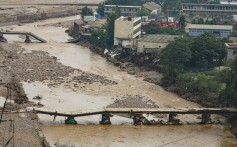
Cina’s Yellow River flooded 10 times more often in past millennium
- Human
interference caused 80 per cent of increased flooding in river known as
the ‘sorrow of China’, study of 12,000 years of data shows
-
- Structural
flood control may boost long-term hazards, lead author says, urging
sustainable river management through soil and water conservation
Flooding in China’s Yellow River became 10 times more frequent in the last 1,000 years than in several previous millennia, and it cannot be blamed on climate change, a new study has shown.
Around 80 per cent of the increased frequency was caused by human interference that transformed and destabilised the river, according to an analysis of 12,000 years’ worth of data by scientists in China and the US.
Modifications that increased flood risk included clearing vegetation for agriculture in the Loess Plateau, which is the main water and sediment source of the lower Yellow River, and building embankments downstream, according to the study published on Thursday in peer-reviewed journal Science Advances.
Cina’s Yellow River flooded 10 times more often in past millennium
- Human
interference caused 80 per cent of increased flooding in river known as
the ‘sorrow of China’, study of 12,000 years of data shows
-
- Structural
flood control may boost long-term hazards, lead author says, urging
sustainable river management through soil and water conservation
Flooding
in China’s Yellow River became 10 times more frequent in the last 1,000
years than in several previous millennia, and it cannot be blamed on
climate change, a new study has shown.
Around 80 per cent of the
increased frequency was caused by human interference that transformed
and destabilised the river, according to an analysis of 12,000 years’
worth of data by scientists in China and the US. Modifications
that increased flood risk included clearing vegetation for agriculture
in the Loess Plateau, which is the main water and sediment source of the
lower Yellow River, and building embankments downstream, according to
the study published on Thursday in peer-reviewed journal Science
Advances.
Modifications
that increased flood risk included clearing vegetation for agriculture
in the Loess Plateau, which is the main water and sediment source of the
lower Yellow River, and building embankments downstream, according to
the study published on Thursday in peer-reviewed journal Science
Advances.
The Yellow River, China’s second and the world’s sixth longest, is called the cradle of Chinese civilisation.
It
is also the world’s most sediment-laden river, its fertile floodplains
attracting human settlement for centuries and its surrounding
landscapes, such as the sediment-rich Loess Plateau in northwestern
China, being used for farming. Historical records, sedimentary
radiocarbon dating and statistical modelling informed the study by the
team of researchers from Jiangsu Normal University, the University of
the Chinese Academy of Sciences (CAS), the CAS’ Institute of Earth
Environment and Institute of Tibetan Plateau Research, Beijing Normal
University, and Coastal Carolina University in the United States.
Historical records, sedimentary
radiocarbon dating and statistical modelling informed the study by the
team of researchers from Jiangsu Normal University, the University of
the Chinese Academy of Sciences (CAS), the CAS’ Institute of Earth
Environment and Institute of Tibetan Plateau Research, Beijing Normal
University, and Coastal Carolina University in the United States. Lead
author Yu Shiyong, professor at Jiangsu Normal University’s school of
geography, geomatics, and planning, noted how the Yellow River had
become known as the “sorrow of China” due to frequent flooding since the
Western Han dynasty (202BC to 9AD).
Lead
author Yu Shiyong, professor at Jiangsu Normal University’s school of
geography, geomatics, and planning, noted how the Yellow River had
become known as the “sorrow of China” due to frequent flooding since the
Western Han dynasty (202BC to 9AD).
Quarter of world’s population at risk from once-in-a-century floods
29 Jun 2022
“Taming
the river became the top priority of central governments during
historical times. Unfortunately, policymakers tended to always choose an
expedient strategy for flood control by simply building dykes along the
river,” Yu said.
But embankments did not appear to have been a good solution in the 2,000-year history of flood control efforts in China.
“If
the levee was not fixed in time after a breach, the flow would either
excavate a new channel along a more favourable topographic gradient or
capture a pre-existing channel in a process known as ‘avulsion’,” Yu
explained.
“As sediment supply originating in the Loess Plateau
continued to increase, siltation started over in the new channel and
embankment followed, thereby beginning the cycle anew.”
In
contemporary China, central government soil and water conservation
projects since the 1990s, such as the “Grain for Green” and “Gully Land
Consolidation” programmes, had substantially reduced flood frequency, Yu
said.
“This successful experience of flood control through soil
and water conservation presents a holistic approach to sustainable river
management.
“[This] should be continued and enforced in China,
to deal with not only the long-term [effects of] climate change, but
also extreme precipitation events, as a warming climate may boost the
global hydrological cycle,” he said, referring to the process by which
water in all its forms – solid, liquid and vapour – circulates around
the world.
Studies have shown that extreme floods and droughts
will become more severe and frequent as global warming progresses, with
climate change intensifying the so-called water cycle.
Such extreme weather events may also pose a greater threat to China’s economic development than previously thought.
In the long term, dam construction should take place alongside the risk-mitigation strategies already in place, Yu advised.
“Our
study confirms previous findings from the Mississippi and Rhine rivers
[in the US and Europe] that structural flood control, despite its
short-term benefits, may boost long-term flood hazards through a suite
of positive feedback loops known as the cascading effect.”
‘No problem at all’ with China’s Three Gorges Dam as warping rumours denied
Zhang
Boting, deputy secretary general of the China Society of Hydropower
Engineering and a defender of dams who was not involved in the study,
said soil and water conservation could be beneficial to flood control,
but their role was not as crucial as reservoir construction.
“When
the energy of falling water is used to generate electricity, erosion is
weakened at reservoirs, fundamentally reducing sediment. Modern dams
are vastly different from defensive river constructions in ancient
history,” he said.
A separate United Nations study published in
December found that around 47,000 large dams worldwide could lose more
than a quarter of their storage capacity by 2050 due to trapped
sediment.
China, which is home to the world’s highest number of
dams in the world, lost about 10 per cent of its storage capacity until
2022 and would lose another 10 per cent by 2050, the study said.
The Yellow River, China’s second and the world’s sixth longest, is called the cradle of Chinese civilisation.
It is also the world’s most sediment-laden river, its fertile floodplains attracting human settlement for centuries and its surrounding landscapes, such as the sediment-rich Loess Plateau in northwestern China, being used for farming.
Historical records, sedimentary radiocarbon dating and statistical modelling informed the study by the team of researchers from Jiangsu Normal University, the University of the Chinese Academy of Sciences (CAS), the CAS’ Institute of Earth Environment and Institute of Tibetan Plateau Research, Beijing Normal University, and Coastal Carolina University in the United States.
Lead author Yu Shiyong, professor at Jiangsu Normal University’s school of geography, geomatics, and planning, noted how the Yellow River had become known as the “sorrow of China” due to frequent flooding since the Western Han dynasty (202BC to 9AD).
Quarter of world’s population at risk from once-in-a-century floods
29 Jun 2022
“Taming the river became the top priority of central governments during historical times. Unfortunately, policymakers tended to always choose an expedient strategy for flood control by simply building dykes along the river,” Yu said.
But embankments did not appear to have been a good solution in the 2,000-year history of flood control efforts in China.
“If the levee was not fixed in time after a breach, the flow would either excavate a new channel along a more favourable topographic gradient or capture a pre-existing channel in a process known as ‘avulsion’,” Yu explained.
“As sediment supply originating in the Loess Plateau continued to increase, siltation started over in the new channel and embankment followed, thereby beginning the cycle anew.”
In contemporary China, central government soil and water conservation projects since the 1990s, such as the “Grain for Green” and “Gully Land Consolidation” programmes, had substantially reduced flood frequency, Yu said.
“This successful experience of flood control through soil and water conservation presents a holistic approach to sustainable river management.
“[This] should be continued and enforced in China, to deal with not only the long-term [effects of] climate change, but also extreme precipitation events, as a warming climate may boost the global hydrological cycle,” he said, referring to the process by which water in all its forms – solid, liquid and vapour – circulates around the world.
Studies have shown that extreme floods and droughts will become more severe and frequent as global warming progresses, with climate change intensifying the so-called water cycle.
Such extreme weather events may also pose a greater threat to China’s economic development than previously thought.
In the long term, dam construction should take place alongside the risk-mitigation strategies already in place, Yu advised.
“Our study confirms previous findings from the Mississippi and Rhine rivers [in the US and Europe] that structural flood control, despite its short-term benefits, may boost long-term flood hazards through a suite of positive feedback loops known as the cascading effect.”
‘No problem at all’ with China’s Three Gorges Dam as warping rumours denied
Zhang Boting, deputy secretary general of the China Society of Hydropower Engineering and a defender of dams who was not involved in the study, said soil and water conservation could be beneficial to flood control, but their role was not as crucial as reservoir construction.
“When the energy of falling water is used to generate electricity, erosion is weakened at reservoirs, fundamentally reducing sediment. Modern dams are vastly different from defensive river constructions in ancient history,” he said.
A separate United Nations study published in December found that around 47,000 large dams worldwide could lose more than a quarter of their storage capacity by 2050 due to trapped sediment.
China, which is home to the world’s highest number of dams in the world, lost about 10 per cent of its storage capacity until 2022 and would lose another 10 per cent by 2050, the study said.




No comments:
Post a Comment
Note: Only a member of this blog may post a comment.